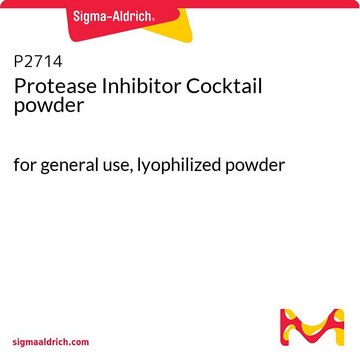34998
Acetonitrile
≥99.9%, HPLC Plus, suitable for IR spectroscopy, HPLC
Synonym(s):
ACN, Cyanomethane, Ethyl nitrile, Methyl cyanide
About This Item
IR spectroscopy: suitable
Recommended Products
Product Name
Acetonitrile, HPLC Plus, ≥99.9%
grade
HPLC Plus
Quality Level
vapor density
1.41 (vs air)
vapor pressure
72.8 mmHg ( 20 °C)
Assay
≥99.9%
form
liquid
autoignition temp.
973 °F
expl. lim.
16 %
baseline drift measuring range
≤12 mAU (210 nm)
technique(s)
HPLC: suitable
IR spectroscopy: suitable
impurities
≤0.0001% free alkali (as NH3)
≤0.0002% non-volatile matter
≤0.001% free acid (as CH3COOH)
≤0.01% water (Karl Fischer)
≤0.5 ppb fluorescence (quinine) at 254 nm
≤0.5 ppb fluorescence (quinine) at 365 nm
halogenated residue
10 ng/L (as heptachlor epoxide)
refractive index
n20/D 1.344 (lit.)
bp
81-82 °C (lit.)
mp
−45 °C (lit.)
density
0.786 g/mL at 25 °C (lit.)
HPLC-gradient
≤0.2 mAU at 254 nm
≤1 mAU at 210 nm
λ
H2O reference
UV absorption
λ: 195 nm Amax: ≤0.10
λ: 200 nm Amax: ≤0.02
λ: 228 nm Amax: ≤0.005
λ: 235 nm Amax: ≤0.0044
λ: 250 nm Amax: ≤0.0044
λ: 400 nm Amax: ≤0.0044
application(s)
food and beverages
format
neat
SMILES string
CC#N
InChI
1S/C2H3N/c1-2-3/h1H3
InChI key
WEVYAHXRMPXWCK-UHFFFAOYSA-N
Looking for similar products? Visit Product Comparison Guide
Related Categories
General description
Application
Mass spectrometry, HPLC, TLC, GPC, UV, IR, GC, Pesticide Residue Analysis, and RNA/DNA Synthesis and Purification.
Packaging
Preparation Note
Other Notes
- The article number 34998-4X2.5L will be discontinued. Please order the single bottle 34998-2.5L which is physically identical with the same exact specifications.
- The article number 34998-6X1L will be discontinued. Please order the single bottle 34998-1L which is physically identical with the same exact specifications.
Legal Information
Signal Word
Danger
Hazard Statements
Precautionary Statements
Hazard Classifications
Acute Tox. 4 Dermal - Acute Tox. 4 Inhalation - Acute Tox. 4 Oral - Eye Irrit. 2 - Flam. Liq. 2
Storage Class Code
3 - Flammable liquids
WGK
WGK 2
Flash Point(F)
35.6 °F - closed cup
Flash Point(C)
2.0 °C - closed cup
Regulatory Information
Choose from one of the most recent versions:
Already Own This Product?
Find documentation for the products that you have recently purchased in the Document Library.
Which document(s) contains shelf-life or expiration date information for a given product?
If available for a given product, the recommended re-test date or the expiration date can be found on the Certificate of Analysis.
How do I get lot-specific information or a Certificate of Analysis?
The lot specific COA document can be found by entering the lot number above under the "Documents" section.
Who do I contact about larger solvent volume needs?
Email us at labessentials@sial.com or visit Sigma-Aldrich Fine Chemicals for development and manufacturing-scale inquiries: safcglobal@sial.com
How do I know what packaging options are available for a solvent?
The Solvent Center gives you the ability to review all the specifications associated with our solvent packaging. This includes physical dimensions, closure types, dispensing methods, UN/DOT Rating as well as solvent compatibility. Visit the Solvent Center.
Who do I contact if I need a solvent blend, which you do not carry?
Email us at labessentials@sial.com. For a complete listing of all our Solvent blends, Visit the Solvent Center
The dispensing of solvents provides some challenges due to the number of container options available. What dispensing options are available for each container?
The Sigma-Aldrich Solvent Center provides numerous dispensing options for each container type. For a complete listing of all our dispensing options, Visit the Solvent Center.
Which solvent grade should I be using for my application?
Sigma-Aldrich Solvent Applications Table gives a guideline to common applications and the appropriate solvent grades. Visit: Solvents
What are the options for drying solvents?
Sigma-Aldrich offers a full range of high-purity solvents with extremely low water levels specifically manufactured for moisture sensitive Organic and Biotech applications. Sigma-Aldrich also carries various drying agents such as molecular sieves, which are typically compatible with organic solvents.
What apparatus do you recommend for HPLC solvent filtration?
The Sigma-Aldrich Vacuum Filtration Assembly gives you all the components you need including: funnel top, fritted glass funnel support, filtration flask, aluminum clamp, and silicone stopper. The Acrodisc Syringe Filters offer high quality filtration for analytical samples, certified for HPLC to ensure low extractable and available in a broad range of membranes to meet sample compatibility requirements.
Can you recommend a Solvent Extractor for organics from aqueous solution?
Solvent extractors are often used for the quantitative extraction of organics from aqueous solutions and separations in immunoassays. The MIXXOR system has been applied successfully in many laboratory solvent extraction operations and is ideal for the rapid screening of alternative solvents for specific extraction problems.
How do I find price and availability?
There are several ways to find pricing and availability for our products. Once you log onto our website, you will find the price and availability displayed on the product detail page. You can contact any of our Customer Sales and Service offices to receive a quote. USA customers: 1-800-325-3010 or view local office numbers.
What is the Department of Transportation shipping information for this product?
Transportation information can be found in Section 14 of the product's (M)SDS.To access the shipping information for this material, use the link on the product detail page for the product.
My question is not addressed here, how can I contact Technical Service for assistance?
Ask a Scientist here.
Protocols
Separation of null
HPLC Analysis of Vitamins B1, B6 and B12 using Ascentis® Express RP-Amide
Our team of scientists has experience in all areas of research including Life Science, Material Science, Chemical Synthesis, Chromatography, Analytical and many others.
Contact Technical Service



